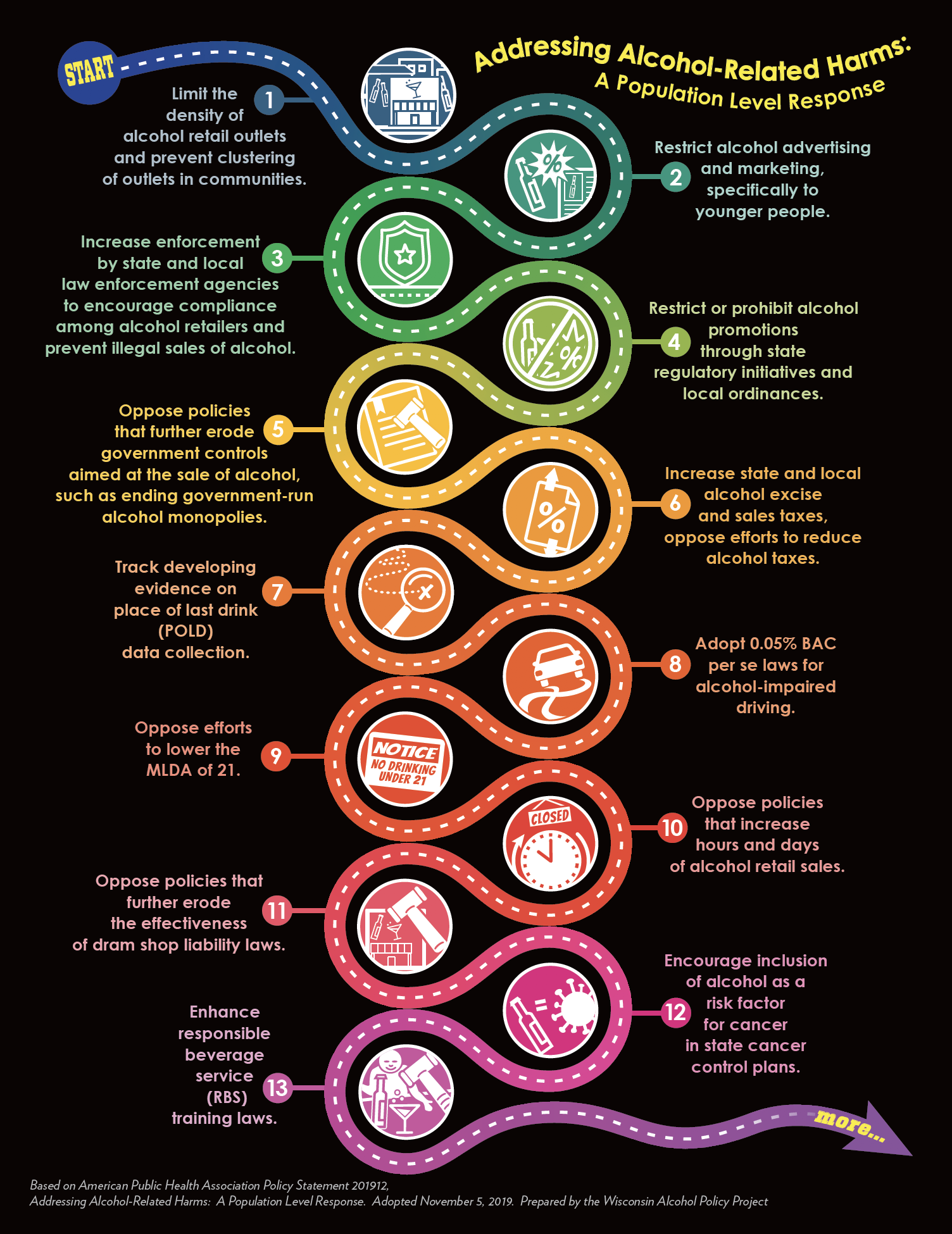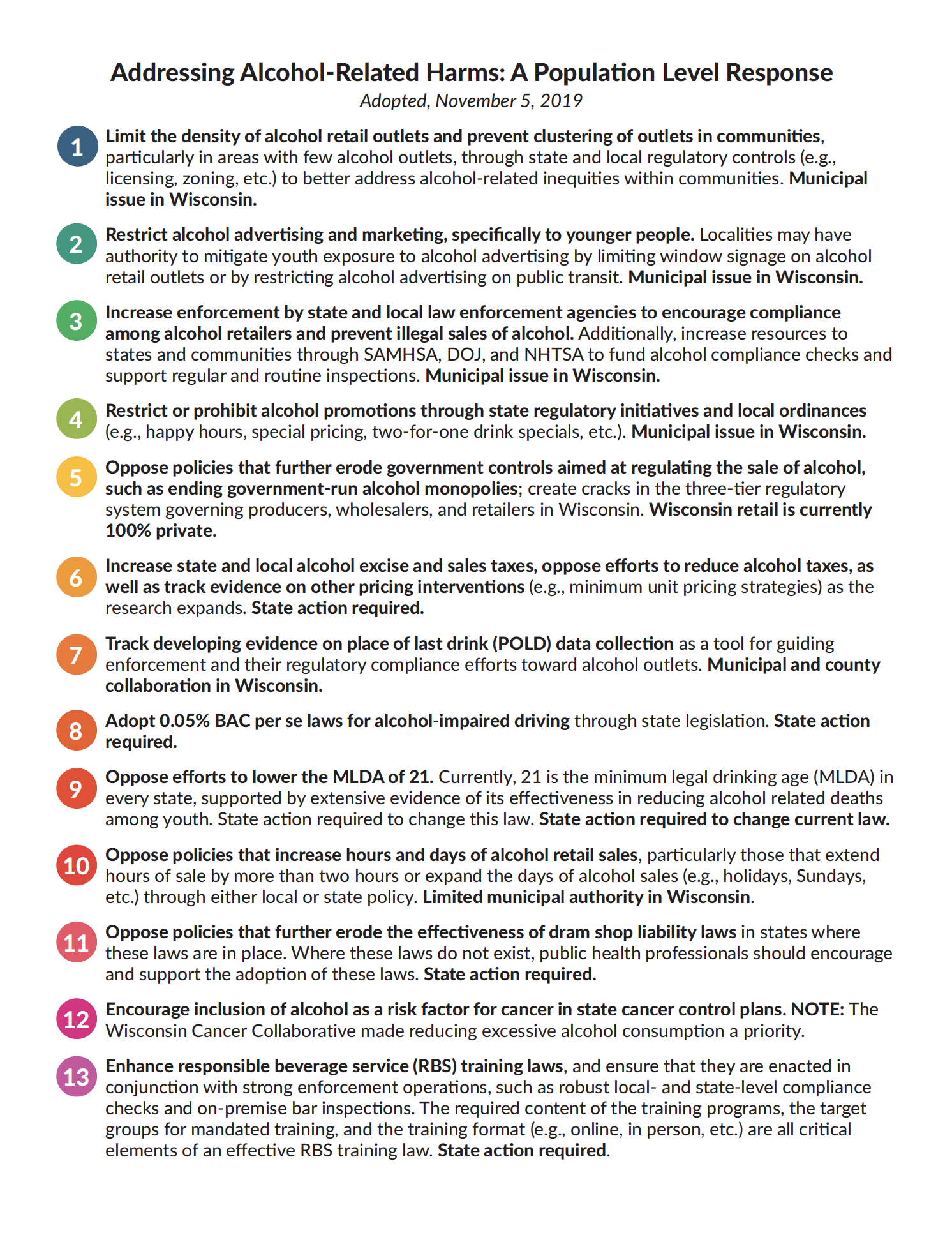By Julia Sherman, Coordinator
Wisconsin Alcohol Policy Project
In November, the American Public Health Association (APHA) created a bridge for local health departments and community groups leading from alcohol awareness education and persuasion to the policies that prevent and reduce excessive consumption. Nationwide excessive alcohol consumption creates human and financial burdens that must be addressed at the population level. This isn’t a new idea. Americans have accepted government policies that improve lives and health for decades. Fluoridated water, iodized salt, automobile seat belts, smoke-free workplaces benefit everyone, decrease health care costs, and improve health and safety.
Alcohol issues are public health issues; most alcohol-related harms are not the result of alcohol dependence because most binge drinkers are not alcohol dependent.
The comprehensive approach reflected in the APHA policy focuses on 13 policy recommendations. Several support enforcements of current laws on selling alcohol to underage youth, others are more controversial, such as reducing the per se BAC level for drunk driving to .05% and increasing alcohol taxes. Each state or each municipality must explore how to implement these policies, but we must act. Use the APHA policy to build the political willpower we need to improve the alcohol environment using these evidence-based policies.
To keep those policies in the forefront of our discussions, the Wisconsin Alcohol Policy Project created an infographic listing all 13 policies with brief explanations on the reverse. Download a PDF for your use and read the policy in full on the APHA website.
These are 13 effective policies that reduce underage and binge drinking, help control law enforcement costs and improve the alcohol environment at the state or local level. It will take local elected leaders, public health agencies, law enforcement and civil society working together to bring these recommendations to life. Given the scope and expense of alcohol misuse in the United States, it may be the most important battle we undertake.
The 13 polices are:

1. Limit the density of alcohol retail outlets and prevent clustering of outlets in communities.
Many communities unintentionally created harmful clusters of alcohol outlets before the full range of consequences were known. Some Wisconsin municipalities adopt narrow guidelines that keep community goals in the forefront of deliberations while limiting the number of outlets.
2. Restrict alcohol advertising and marketing, specifically to younger people.
In 2019, New York City banned alcohol advertising on city owned bus shelter, recycling can, newsstands and kiosks. Increasingly, municipal leaders are seeing the wisdom of prohibiting alcohol advertising on public property including transit system, in parks and recreational areas.
3. Increase enforcement by state and local law enforcement agencies to encourage compliance among alcohol retailers and prevent illegal sales of alcohol.
Alcohol age compliance checks significantly reduce youth access to alcohol. In North Dakota, the McKenzie County Community Coalition works with law enforcement agencies on alcohol age compliance checks with fines for both the retailer and clerk in locations that fail.
4. Restrict or prohibit alcohol promotions through state regulatory initiatives and local ordinances,
Local ordinances can ban promotions that encourage excessive drinking such as flat rate or “all you can drink” events. These could be very useful in campus communities where semester, sports or event-based specials often lead to binge drinking.
5. Track developing evidence on place of last drink (POLD) data collection. 
More than 25 municipalities in the Twin Cities area are compiling Place of Last Drink data on all arrests and incidents. POLD data collection allows law enforcement to focus their efforts on licensees who display a pattern of illegal over-serving that results in alcohol-related crime and disorder.
6. Increase state and local alcohol excise and sales taxes, oppose efforts to reduce alcohol taxes.
Alcohol tax increases are indisputably the single most effective way to reduce underage and binge drinking, as well as providing additional state revenue that are paid in direct relationship to the amount of alcohol an individual consumes.
7. Adopt 0.05% BAC per se laws for alcohol-impaired driving through state legislation.
In 2013, the NTSB recommended lowering the per se BAC for drunk driving to .05. Utah lowered its per se level to .05 last year and the Hawaiian legislature is currently considering a similar proposal. Several other countries, including France and Australia, currently have a .05 blood alcohol per se rate.
8. Oppose policies that further erode government controls to regulate the sale of alcohol.
Prevention and public health professionals both need to consider the agencies and programs that identify and control alcohol licensing, advertising and pricing, and work to support those existing controls.
9. Oppose efforts to lower the MLDA of 21.
The 21 minimum legal drinking age has literally saved thousands of young lives. According to the World Health Organization’s Global Health Observatory, 12 other nations have also adopted the 21 MLDA.[i]
10. Oppose policies that increase hours and days of alcohol retail sales,
While adding an hour or two to the sales days may seem innocuous, increases in the availability of alcohol can increase community consumption over time. Studies have found that increasing hours of sale by two hours or more increases vehicle crashes, emergency room admissions and alcohol-related injuries.[ii]
11. Oppose policies that further erode the effectiveness of dram shop liability laws.
While only six states impose liability on locations that sell or serve alcohol, 21 states have major limitations on commercial liability. The CDC found that states with dram shop liability had significantly fewer alcohol-related motor vehicle deaths.[iii]
12. Enhance responsible beverage service (RBS) training laws.
Beginning next year in California, all alcohol server and their manager must have a valid RBS certification from an ABC accredited RBS training provider and pass an online ABC administered RBS exam within 60 calendar days from the first date of employment.
13. Encourage inclusion of alcohol as a risk factor for cancer in state cancer control plans.
Nationally, less than one-fourth of the Cancer Control Plans have a measurable objective to reduce excessive or underage drinking. Knowing the link between alcohol and cancer supports better personal decisions and an awareness of the full scope of alcohol-related medical costs.
[i] World Health Organization Global Health Observatory
[ii] Task Force on Community Preventive Services. Recommendations on maintaining limits on days and hours of sale of alcoholic beverages to prevent excessive alcohol consumption and related harms. Am J Prev Med2010;39(6):605-6
[iii] Community Preventive Services Task Force. Preventing excessive alcohol consumption: dram shop liability external icon. In: Guide to Community Preventive Services. Updated Mar 2010.